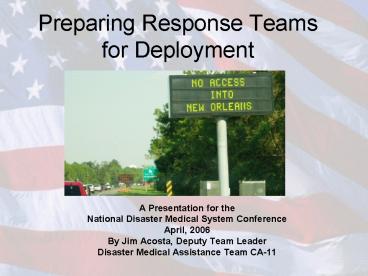Preparing Response Teams for Deployment - PowerPoint PPT Presentation
1 / 47
Title: Preparing Response Teams for Deployment
1
Preparing Response Teams for Deployment
- A Presentation for the
- National Disaster Medical System Conference
- April, 2006
- By Jim Acosta, Deputy Team Leader
- Disaster Medical Assistance Team CA-11
2
Greetings From SacramentoHome of DMAT
CA-11Andthe Governator
3
Hes a Hell of a Guy,
- Unit Commander, 2004-2005
- Now Deputy Unit Commander
- 21 Years in Public Safety
- 1995 Police Officer of the Year
and He Does a Hell of a Job
4
Whos Here?
- NDMS teams?
- Military?
- Red Cross?
- HHS/CDC/PHS?
- State/local?
- NGOs
- Everybody else?
- Welcome!
5
Objectives Overview
- Why Disaster Response is Different from
non-Disaster Responses - Identify Important Elements of Individual
Preparedness - Various Approaches to Team Readiness
6
Different, and Yet Similar
7
Nature of Medical Disaster Response
- Ad-hoc Group
- Deploy to Another Location
- Stressful Conditions
- Need to Perform Well Together
- Accomplish Assigned Mission
8
Phases of a Disaster Deployment
9
Pre-Deployment
- Ongoing Team Training and Maintenance
- Deployment/Callout Plans and Mechanism
- Keep Your People Interested-Communicate!
- Challenge Your People
10
Team Assembly
- One of the Most Difficult Phases
- Skills and Personalities
- Dont Waste the Down Time
11
Team Movement
- Convoy Driving with/without Communications
- Use Distinctive Markings
- Pre-select Fallback Assembly Points
- Work Convoy Practice into Drills
12
Staging
- A Necessary Evil
- Short-term
- Long-term
- Brief, Focused Training
- Frequent Briefings
13
Field Assignment
- Buddy System
- Accountability
- Communications
- Re-supply
14
Field Operations
- Old Missions, New Challenges
15
Alternate Assignments
16
Demobilization
- Complex Process
- Administrative
- Physical
- Mental
17
Rotation of Personnel
- Lingering Disaster Strains Resources
- Individual Deployments risk
- Less Institutional Support
- Disaster Fatigue
- Less Employer Support
- Team Leadership Needs to Provide
Additional Support to These Members
18
Rehab
- Body, Mind, Soul
- Ongoing Process
- Post-Deployment
- CISM?
19
Objective 1
- Explain Why Disaster Response is Different from
Typical Pre-hospital Responses.
20
Local Infrastructure Overwhelmed
- Collapse of Normal 911 Response System
21
Mission is Unpredictable
- May Not Match Pre-Conceived Notions
- May Be Beyond Your Peoples Experience
- May Not Be Fulfilling Enough
22
Length of Mission is Variable
- Longer or Shorter Than Expected
- Personal Issues May Intrude from Home
23
Objective 2
- Identify Some Important Individual Preparedness
Requirements.
24
Personal Preparation, Training, Equipment
- No Substitute
- No Excuse
- Leadership
- Verify
25
Specific Disaster-related Knowledge
- NIMS
- Command Structure-Team and Overhead
- Team Equipment-Tents, Litters, Cache
- How Victims Can Get Assistance
26
Technical Competence
- Medical Specialty
- Logistical
- Response Equipment
- Communications
27
Interpersonal Skills
- Conflict Resolution
- Self-Reliance
- Personal Initiative
- Customer Service
28
Mental Flexibility
- Patience
- Mission Ownership
- Take Care of Each Other
- Know When to Seek Help
29
Preconceptions
- Everyone Has Expectations of What They Will Be
Doing at the Disaster Site - Reality is Often Very Different
- Conflict Can Cause Problems
30
Use PreconceptionsTo Your Advantage
- Group Discussion Prior to Travel
- Visualization
- Leadership Must Set The Example
31
Objective 3
- Describe Various Approaches to Team Readiness.
32
Team Agility
- The Quality of Moving Quickly With Nimbleness
- Maximize Critical Skills Across Many Members
- Encourage Cross Training and Expertise
- Be Invaluable.
33
Personnel Readiness
- Personal Gear
- Position-Specific Competencies
- Austere Environment
34
Challenge for Team Leadership
- Harness/Use Good Qualities/Efforts
- Control/Minimize Negative Behaviors/ Interactions
- Mid-level Supervision needs your Guidance to be
Successful
35
Positive/Negative Attributes
- Best Assessed in Advance
- Stress Reveals Underlying Quirks
- Address Individual Problems Before They Become a
Management or Morale Problem - In Extreme Cases, SEND THEM HOME
36
Humor/Stress Reduction
- Members look to leaders to set the tone
- Blow off some steam!
37
Addressing Monotony
- Versatile Game Items-Cards, Inflatable Ball
- Movies/Music for Off-Duty Personnel
- Shopping/ Procurement Trips
38
Establish Routines
- Regular Briefings
- Shift/Duty Rotations
- Assign Chores
- Anything to Establish Patterns
39
Team Equipment
40
Confident Use of Equipment
- BoO Equipment-Tents, Showers, Latrines
- Medical Devices-Ventilator, O2 Manifold, Lifepaks
- Communications-Radios, Satellite Phone, Fax
41
Equipment-related Problems
- Not Having the Right Equipment
- Not Knowing How to Use Equipment
- Not Having a Power Source
- Not Knowing How to Get What You Need
42
Have Your Experts Make Job Aids
- Simple
- Essential Tasks
- Essential Info
- Not a Substitute for Training
43
Fault Tree Analysis
- ID points of catastrophic failure
- Mitigate minor issues (PM, Spares)
- The 1.25 Tees
- Create Failure Drills
44
Shuttle Challenger Fault Tree
45
Aviation
- Safety-Working Around Aircraft, Winch Lines
- Landing Zones
- Communications with Flight Crews
46
Audience Discussion
47
A Parting Thought
- But who are ye, in rags and rotten shoes,
- You dirty-bearded, blocking up the way?
- We are the Pilgrims, master
- we shall go always a little further
- it may be beyond that last blue mountain
- barred with snow, Across that angry
- or that glimmering sea
- The Golden Journey to Samarkand, James Elroy
Flecker































